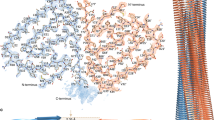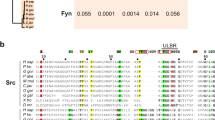Abstract
Src-homology 3 (SH3) domains bind to proline-rich motifs in target proteins. We have determined high-resolution crystal structures of the complexes between the SH3 domains of Abl and Fyn tyrosine kinases, and two ten-residue proline-rich peptides derived from the SH3-binding proteins 3BP-1 and 3BP-2. The X-ray data show that the basic mode of binding of both proline-rich peptides is the same. Peptides are bound over their entire length and interact with three major sites on the SH3 molecules by both hydrogen-bonding and van der Waals contacts. Residues 4-10 of the peptide adopt the conformation of a left-handed polyproline helix type II. Binding of the proline at position 2 requires a kink at the non-proline position 3.
This is a preview of subscription content, access via your institution
Access options
Subscribe to this journal
Receive 12 print issues and online access
$189.00 per year
only $15.75 per issue
Buy this article
- Purchase on Springer Link
- Instant access to full article PDF
Prices may be subject to local taxes which are calculated during checkout
Similar content being viewed by others
References
Musacchio, A., Gibson, T., Lehto, V.-P. & Saraste, M. SH3 — an abundant protein domain in search of a function. FEBS Lett. 307, 55–61 1992.
Mayer, B.J. & Baltimore, D. Signaling through SH2 and SH3 domains. Trends Cell Biol. 3, 8–13 1993.
Pawson, T. & Schlessinger, J. SH2 and SH3 domains. Curr. Biol. 3, 434–442 1993.
Cicchetti, P., Mayer, B.J., Thiel, G. & Baltimore, D. Identification of a protein that binds to the SH3 region of Abl and is similar to Bcr and rho-GAP. Science 257, 803–806 1992.
Fry, M.J. Defining a new GAP family. Curr. Biol. 2, 78–80 1992.
Ridley, A.J. & Hall, A. The small GTP-binding protein rho regulates the assembly of focal adhesions and actin stress fibers in response to growth factors. Cell 70, 389–399 1992.
Ridley, A.J., Paterson, H.F., Johnston, C.L., Diekmann, D. & Hall, A. The small GTP-binding protein rac regulates growth-factor induced membrane ruffling. Cell 70, 401–410 1992.
Mayer, B.J., Ren, R., Clark, K.L. & Baltimore, D. A putative modular domain present in diverse signaling proteins. Cell 73, 629–630 1993.
Ren, R., Mayer, B., Cicchetti, P. & Baltimore, D. Identification of a ten-amino acid proline-rich SH3 binding site. Science 259, 1157–1161 1993.
Gout, I. et al. The GTPase dynamin binds to and is activated by a subset of SH3 domains. Cell 75, 25–36 1993.
Yu, H. et al. Structural basis for the binding of proline-rich peptides to SH3 domains. Cell 76, 933–945 1994.
Musacchio, A., Noble, M.E.M., Pauptit, R., Wierenga, R.K. & Saraste, M. Crystal structure of a Src-homology 3 (SH3) domain. Nature 359, 851–855 1992.
Noble, M.E.M., Musacchio, A., Saraste, M., Courtneidge, S. & Wierenga, R. K. Crystal structure of the SH3 domain in human Fyn. Comparison of the three-dimensional structures of SH3 domains in tyrosine kinases and spectrin. EMBO J. 12, 2617–2624 1993.
Kohda, D. et al. Solution structure of the SH3 domain of phospholipase C-γ. Cell 72, 953–960 1993.
Yu, H., Rosen, M.K., Shin, T.B., Seidel-Dugan, C., Brugge, J.S. & Schreiber, S.L. Solution structure of the SH3 domain of Src and identification of its ligand-binding site. Science 258, 1665–1668 1992.
Booker, G.W. et al. Solution structure and ligand-binding site of the SH3 domain of the p85a subunit of phosphatidylinositol-3'-kinase. Cell 73, 813–822 1993.
Koyama, S. et al. Structure of the PI3K SH3 domain and analysis of the SH3 family. Cell 72, 945–952 1993.
Borchert, T.V., Mathieu, M., Zeelen, J.Ph., Courtneidge, S.A. & Wierenga, R.K. The crystal structure of human CskSH3: structural diversity near the RT-Src and n-Src loop. FEBS Lett. 341, 79–85 1994.
Yang, Y.S. et al. Solution structure of GAP SH3 domain by 1H NMR and spatial arrangement of essential Ras signaling-involved sequence. EMBO J. 13, 1270–1279 1994.
Eck, M.J., Atwell, S.K., Shoelson, S.E. & Harrison, S.C. Structure of the regulatory domains of the Src-family tyrosine kinase Lck. Nature 368, 764–769 1994.
Songyang, Z. et al. SH2 domains recognize specific phosphopeptide sequences. Cell 72, 767–778 1993.
Stern, J.L et al. Crystal sructure of the human class II MHC protein HLA-DR1 complexed with an influenza virus peptide. Nature 368, 215–221 1994.
Lim, W.A. & Richards, F.M. Critical residues in an SH3 domain from Sem-5 suggest a mechanism for proline-rich peptide recognition. Nature struct. Biol. 1, 221–225 1994.
Lowenstein, E.J. et al. The SH2- and SH3-containing proteinGRB2 links receptor tyrosine kinases to RAS signaling. Cell 70, 431–442 1992.
Kabsch, W. Evaluation of single-crystal X-ray diffraction data from a position-sensitive detector. Acta. cryst. Sect. A21, 916–924 1988.
Navaza, J. On the fast rotation function. Acta Crystallogr. A43, 645–653 1987.
Brünger, A.T., Kuriyan, J. & Karplus, M. Crystallographic R factor refinement by molecular dynamics. Science 235, 458–460 1987.
Lamzin, V.S. & Wilson, K.S. Automated refinement of protein models. Acta cryst. Sect. D49, 129–147 1993.
Jones, T.A., Zou, J.-Y., Cowan, S.W., Kjeldgaard, M. Improved methods for building protein models in electron density maps and the location of errors in these models. Acta cryst. Sect. A47, 110–119 1991.
Musacchio, A., Wilmanns, M. & Saraste, M. Structure and function of the SH3 domain. Prog. Biophys. molec. Biol. 61, 283–297 1994.
CCP4-package (Daresbury Laboratory, England, 1979).
Studier, F., Rosenberg, A.H., Dunn, J.J. & Dubendorff, J.W. Use of the T7 RNA polymerase to direct expression of cloned genes. Methods Enzymol. 185, 60–89 1990.
Kraulis, P.J. MOLSCRIPT: a program to produce both detailed and schematic plots of protein structures. J. appl. Crystallogr. 24, 946–950 1991.
Nicholls, A., Sharp, K.A. & Honig, B. Protein folding and association: insights from the interafacial and thermodynamic properties of hydrocarbons.. Prot. Struct. Fund. Genet. 11, 282–293 1991.
Author information
Authors and Affiliations
Rights and permissions
About this article
Cite this article
Musacchio, A., Saraste, M. & Wilmanns, M. High-resolution crystal structures of tyrosine kinase SH3 domains complexed with proline-rich peptides. Nat Struct Mol Biol 1, 546–551 (1994). https://doi.org/10.1038/nsb0894-546
Received:
Accepted:
Issue Date:
DOI: https://doi.org/10.1038/nsb0894-546
This article is cited by
-
An allosteric switch between the activation loop and a c-terminal palindromic phospho-motif controls c-Src function
Nature Communications (2023)
-
SH3 domain regulation of RhoGAP activity: Crosstalk between p120RasGAP and DLC1 RhoGAP
Nature Communications (2022)
-
Novel mutations in the kinase domain of BCR-ABL gene causing imatinib resistance in chronic myeloid leukemia patients
Scientific Reports (2019)
-
A lack of peptide binding and decreased thermostability suggests that the CASKIN2 scaffolding protein SH3 domain may be vestigial
BMC Structural Biology (2016)
-
Conformational change of Sos-derived proline-rich peptide upon binding Grb2 N-terminal SH3 domain probed by NMR
Scientific Reports (2013)



